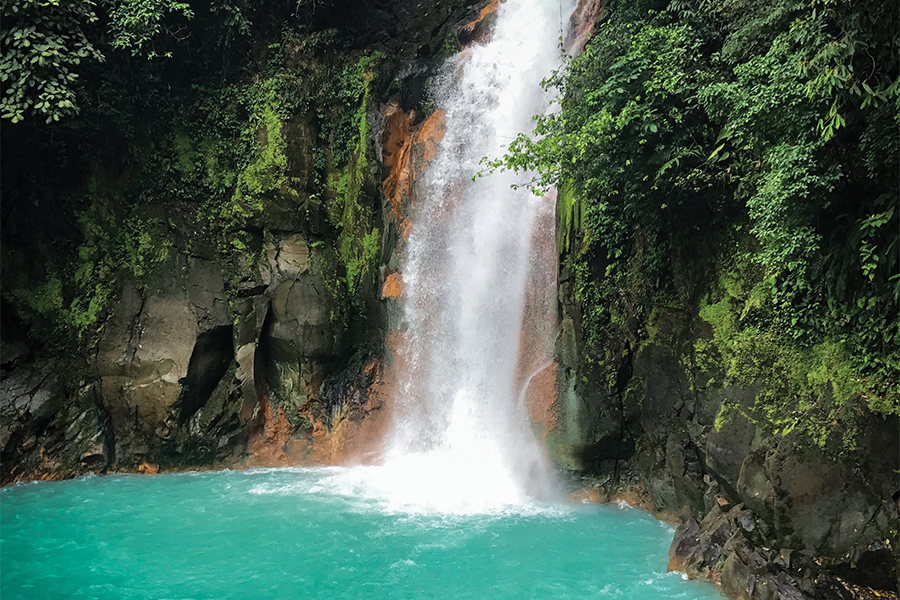Sisters on Safari

Kindred spirits with a shared love of adventure, sisters Renata Faeth and Kelley Nichols hatched a plan that included all the elements of a blockbuster vacation: brilliant landscapes with unforgettable sunsets, cultures rich in history and tradition, and best of all, the great creatures of planet earth roaming freely before their eyes. Three years and two pandemic delays later—ready, eager and khaki-clad—they made it to Africa.
First Stop: Cape Town, South Africa
Renata:
Afro-pop music blared on the radio as we breezed into town on a sunny winter morning, gazing out the window at a city getting its groove back. Our driver gave us the lay of the land: Cape Town, affectionately known as South Africa’s “Mother City,” was officially founded in 1652 by the Dutch East India Company as a refueling station for eastbound ships on the Maritime Silk Road—and it’s also home to the country’s Indigenous Khoisan people, who arrived about 1,500 years before that. A multi-ethnic city with an often-turbulent history, Cape Town is endlessly fascinating, and its setting—wedged between mountains and the ocean at the southwestern tip of Africa—makes it one of the prettiest cities in the world.
Kelley:
Cape Town offers something for everyone, from hiking the foothills of Table Mountain, the spectacular flat-topped colossus that defines the entire city, to sampling the hip restaurants in Bo-Kapp, the city’s artistic center, to wandering the venerable waterfront with its Dutch and British seafaring influences.
Immediately outside the city are stunning wineries where the most sophisticated oenophiles (wine lovers) can indulge in day-long tasting tours. For outdoor enthusiasts, there is spectacular scenery all along the Cape Peninsula, including Cape Point, the Cape of Good Hope and nearby Simon’s Town, with its colony of adorable South African penguins.
But Renata and I also believed that a trip to Cape Town would not be complete without a visit to Robben Island, where the nation’s first president of Black African descent, Nelson Mandela, was held for 18 of his 27 years in prison. The island tour is given by former inmates and provides as complete an understanding as is possible of the nation’s struggles with race and colonialism, and of the remarkable ascent of Mandela, who sought to unify a nation around their common inheritance.
Second Stop: Thornybush Saseka Tented Camp, Near Kruger National Park, South Africa
Renata:
“Rudy, is it true the male lion lies around all day while the lionesses have to fetch his food?”
“How much does a baby elephant weigh at birth?”
“How fast can a hippo swim?”
Leaning forward from our Land Cruiser’s elevated seats, we peppered our well-trained, conservation-minded safari guide with questions, who happily obliged with animal kingdom fun facts.
Thornybush is one of several private game reserves bordering Kruger National Park in South Africa’s northeast region, just a two-hour flight from Cape Town. Animals move freely across park boundaries, but in the reserve, there are no set hours limiting game drives and few self-drivers on the roads. What’s more, safari guides can take 4WD vehicles off-road over dry, gnarly brush, stoking the thrill of tracking a solitary leopard, a pack of African wild dogs, or a family of white rhinos grazing in a secluded meadow.
While Rudy drove the Land Cruiser, Jordan, his tracker, sat perched on the front bumper’s jump seat, looking out for paw prints, animal dung and other signs of wild game—reading what they jokingly referred to as the “morning news.” Everyone wants to see Africa’s “Big Five” (lion, leopard, rhinoceros, cape buffalo, and elephant), and while they tracked whatever came their way, they always seemed aware of who had checked off what. No matter which creature we stumbled upon—from the humble dung beetle to a parade of elephants—they were as excited as we were.
Kelley:
We lived well at Thornybush. The Saseka tents are “glamping” at its best: They manage to communicate luxury and elegance while maintaining the connection to a wild exterior. The furniture is either bespoke canvas and metal or cleverly adapted antiques, and the ceiling canvas is decorated with Victorian botanical illustrations of local grasses and flowers. The total effect is so subtle that you forget you are in a tent until you hear a hyena howl or the swoosh of nyalas in the surrounding forest.
The food and service are also top notch. Each traveling group is assigned a “butler”—in our case, a bright young woman named Kedris—to help with food service, answer questions and see to any unusual requests. The food was outstanding: unique breakfast, lunch and dinner offerings that included local wild game, as well as vegan options at every meal. Plus, of course, a range of excellent South African wines.
Third Stop: Victoria Falls, Zambia and Zimbabwe
Renata:
A popular stopover for southern Africa safari trips, Victoria Falls makes the continent’s original bucket list. Scottish explorer and missionary David Livingstone came upon it during an expedition down the Zambezi River in 1855, with the help of local tribes who had long considered it sacred territory. He named it after his Queen Victoria, but its precolonial name, Mosi-oa-Tunya, comes from the native Lozi language, meaning “The Smoke That Thunders”—an apt metaphor for the largest curtain of falling water in the world. The falls tumble over a series of six gorges in zig-zagging fashion at the border of Zambia and Zimbabwe, producing a torrent of water 5,600 feet wide, with an average depth of about 330 feet and spray that can be seen up to 30 miles away.
I may not remember those statistics, but I won’t forget how I felt gazing at a double rainbow catching the early morning mist and laughing, as the sheer force of the spray drenched me from head to toe. The awe of capturing the once-monthly lunar rainbow over the falls—a phenomenon visible only a few places on earth during a full moon—was a gift from Mother Nature I’ll always treasure.
Also unforgettable: the gracious, safari-style Royal Livingstone Hotel, located upriver just a 10-minute walk from the falls, and known for red-orange sunsets that linger as the moon rises over the water. It’s also famous for zebras and giraffes wandering about and plucky tree monkeys that wait for hotel room doors to open, so they can dash in and grab sugar packets off the coffee tray. On the night we arrived, Kelley suggested I check out the statue of a kneeling giraffe just below our balcony. “It’s chewing,” I told her, doing a double take. “Wait—that’s a real giraffe!” We still laugh about it.
Last Stop: Muchenje Safari Lodge, Near Chobe National Park, Botswana
Kelley:
We traveled overland to Botswana from Victoria Falls, with a bravado of certainty that we had already “seen it all.” But Botswana proved us wrong on our first game drive. The vast horizons of Chobe National Park are dotted with scores of animals—so many that some escape the eye. We saw dozens of elephants, including a group of five swimming, using their trunks as snorkels, as well as dazzles of zebras and journeys of giraffes moving in their silent elegance across the landscape. Lions lolled lazily in the bushes or arranged in small hunting teams scheming for their next meal, and bloats of hippos surfaced noisily, yawning and grinning from the cool comfort of their mud baths.
Renata:
The lovely Muchenje Safari Lodge is a family-owned property, featuring well-appointed cottages tucked into the hillside, with spectacular views above the Chobe River basin. It was flood season during our stay, so the water was high enough to draw a multitude of birds and wildlife to its banks but low enough to capture the striking silhouette of acacia trees across the savannah. Safaris come in all varieties here: by Land Cruiser, on a riverboat and on optional walking tours. The hospitality is cozy; homestyle meals are served at a long table by a caring staff who entertain guests at dinner with a traditional dance program, providing an authentic atmosphere we all love at the end of a trip.
Southern Africa Planning Tips
Consider the Season:
Winter (June through August) can be rainy and cool on the cape but dry and cool in in Kruger National Park and bordering countries to the north. The early morning (6-9 a.m.) and evening (4-7 p.m.) game drive temperatures can dip into the upper 40s, but it warms up quickly in the sun; and since the brush is dry, animals may be easier to see. Summer (December through February) is sunny and hot on the cape, but the northern bush can see occasional rainfall. It’s also the time of year when many animal species give birth, so young critters are plentiful.
Pack Light:
Even in South Africa’s winter months, three changes of clothing may be sufficient, since laundry service is always available. You may want that extra space in your luggage for souvenirs like jewelry and wood carvings for mementos and gift giving later. On winter safaris, game drive vehicles are packed with blankets and hot water bottles, but a warm jacket and hat are essential. Summertime—which is mosquito season—calls for lightweight clothing, including long pants and socks that cover your ankles.
Book Well in Advance:
An African safari adventure is a trip of a lifetime for most, with a long dream-before-commitment stage, but current pent-up demand means travel companies are booking up to two years out. The benefit? Extra time to secure preferred air tickets and lodging, and best of all, to savor the joy of anticipation.





